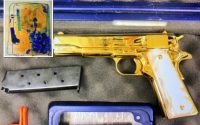‘Astounding’ 2000-year-old Roman building discovered beneath Switzerland quarry — first of its kind in a century
A massive 2,000-year-old complex containing a trove of ancient Roman artifacts was uncovered beneath a Switzerland gravel quarry — the first find of its kind in almost a century.
Archeologists announced last week that they have been slowly and carefully excavating the remains of what was once an “impressive building complex” that has been lying beneath the forest floor in the foothills of the Alps for thousands of years.
The discovery is extremely rare for the country, and it is the first time a relic of such grand size has been found in the area in nearly a century.
“Only a few structural relics of this kind from the Roman period are known in the pre-Alpine region – in contrast to other regions. What is also astounding is the relatively good preservation of the remains,” Christa Ebnöther, Professor of Archeology of the Roman Provinces at the University of Bern, said in a statement.
Though the complex has yet to be completely uncovered, archeologists estimate that its walls extend over an area of at least 5,300 square feet and contain multiple rooms.
What purpose the monumental building served has yet to be discovered, with scientists questioning whether it was a temple or simply a villa that provided a view of the stunning mountains and reservoirs surrounding what would later become the quarry.

Items discovered thus far inside the structure are already giving archeologists an insight into the lives of ancient Romans who called the Swiss Alps home around 20 A.D.
Roman tableware — or so-called terra sigillata — and manufactured glass vessels, as well as gold fragments likely once belonging to a piece of jewelry have already been lifted from the ruins for preservation.
In addition to copper and bronze coins, a silver coin of Julius Caesar from the 1st century BC was also found. The face of the coin shows an elephant trampling on a dragon or snake.



“Fragments of amphorae, in which, among other things, wine, olive oil and fish sauce made their way from the Mediterranean region to the Äbnetwald near Cham, bear witness to the extensive trade in Roman times,” the Office for the Preservation of Monuments and Archaeology stated in a release.
“Large numbers of iron nails speak for a wooden construction on the existing wall foundation.”
While valuable relics from various peoples have been discovered in the area in recent decades — including remains of a settlement from the Middle Bronze Age, graves from the late Bronze Age and numerous coins from the Celtic era — ruins from ancient Rome is a rare find in the Alps.

Archeologists have been systematically digging out the stone building since partial remains were first seen poking out of the ground at the beginning of the year.
After thorough examination, they will remove the walls in favor of a more secure, indoor home for preservation.
Before then, however, the public will be invited to see the ruins and the archeologists in action next week and learn from the professionals what lessons the relics can teach.
“These pieces of the puzzle make it possible to trace the life of our ancestors and to better understand our history,” said Karin Artho, head of the Office for Monument Preservation and Archaeology.


